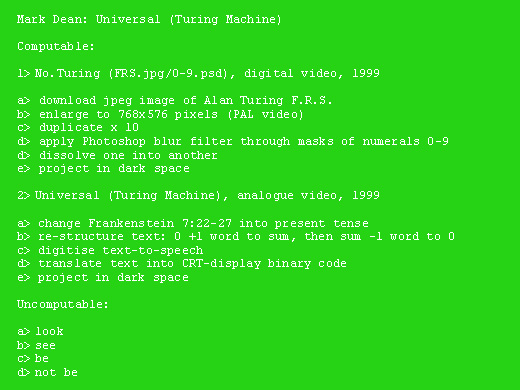Imaginaria ’99
ICA, London
2 – 31 Oct 1999
Mark Dean, Nina Pope & Karen Guthrie, Mongrel, Scanner & Tonne
bibliography:
Kodwo Eshun & John Sutherland, Imaginaria ’99, ICA, London, ISBN 1-9000300-23-0
Simon Morrissey, ‘Nothing here, nothing to fear: The work of Graham Gussin and Mark Dean’, Contemporary Visual Arts, October 1999, No. 25
Dr. Future ‘Making the Right Connections’, Mute, Issue 15, Dec 1999
Jonathan Romney, ‘Living in a gee-whiz age’, The Guardian, October 6 1999
Lynn MacRitchie, ‘Life’s a virtual beach on fantasy island’, FT, 22 October 1999
‘Mark Dean: Imaginaria’, Sight and Sound, November 1999
Simon Morley, ‘Imaginaria 99′, The Independent on Sunday, 10 October 26, 1999
‘Techno YBAs’, Blueprint, No. 165, October 20, 1999
Martin Herbert, ‘Imaginaria: ICA’, Time Out, 20-27 October 1999
Caroline Smith, ‘ Memory Machine: Mark Dean’, Attitude, October 1999
‘PC Art’, Gay Times, October 1999
Charlotte Mullins, ‘Visual Art Choice’, The Independent on Sunday, 26 September 1999
Julian Stallabrass ‘Art I Like’, Modern Painters, Summer 2000
exhibited works:
gallery information:

Jonathan Romney, ‘Living in a gee-whiz age’, The Guardian, Wednesday October 6, 1999 →
…Oddly enough, the most affecting exhibit doesn’t have a website, and functions in the most classic installation fashion. Mark Dean’s Universal (Turing Machine) is a tribute to Alan Turing, the pioneer of digital logic. Two [sic] large digital photos of Turing dissolve and reform, the features blurring as numbers morph over his face, so slowly you can barely see the change. Meanwhile, an electronic voice gives a fragmented reading of a soliloquy from Frankenstein, and a binary-code representation of the words flashes on the ceiling like a map of the stars. Simple and solemn, but extremely rich in connotations, Dean’s piece evokes the chimera of the conscious electronic brain, the “monster” of artificial intelligence returning to pay homage to the father who could never have predicted the fate of his offspring. The piece may seem traditional and stuffy in its concern for mystery and a sense of the sublime, but seems particularly daring in the over-heated new digital rhetoric.
We’re used to celebrating the newness of digital possibilities, the immediacy of the internet, the sense of digital communication as a game open to all comers simultaneously, but Dean is going provocatively against the grain, opting for slowness, stillness and contemplation, a spot of philosophical sobriety among the wow (or should that be “Wow!”?) and flutter.


